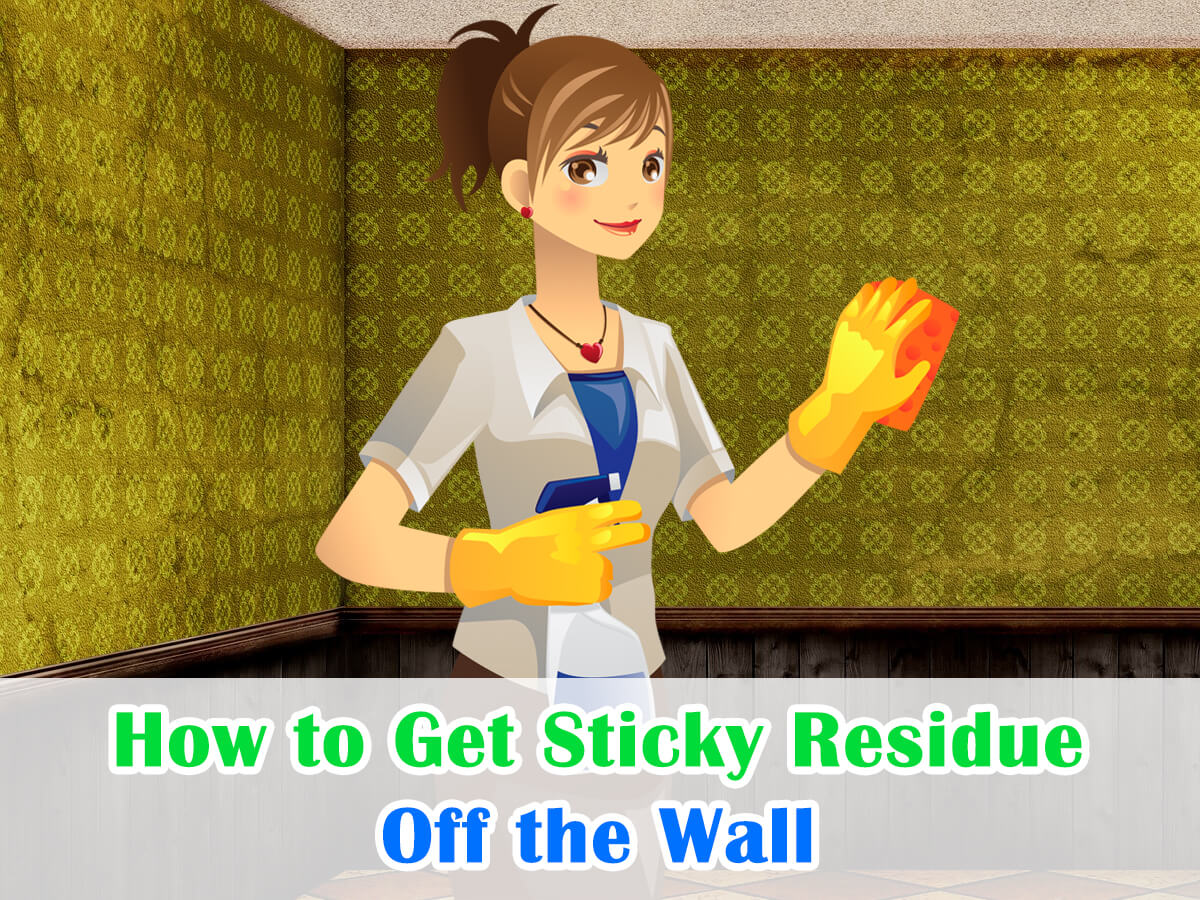We’ve all been there: peeling off a poster, sticker, or old tape only to find a stubborn, sticky residue clinging to the wall. An unwelcome reminder of what once was, this sticky residue can mar the look of your once pristine walls. But fear not! With a few household items and some elbow grease, it’s possible to get sticky residue off the wall without damaging the paint. Let’s get started!
How to Get Sticky Residue Off the Wall
1. Assess the Situation
Before you dive in, take a moment to assess the situation. How large is the area covered by the residue? Is it a small patch, or has it spread over a wide area? What kind of wall surface are you dealing with? Are the walls painted or wallpapered? What kind of adhesive was used? Answering these questions will help you determine the best course of action.
Remember that it’s always better to start gently, and then increase the intensity if required. This way, you can avoid potential damage to the wall surface. So, regardless of how large or small the sticky patch is, start with the least invasive method.
2. Gather Your Materials
For the first approach, you’ll only need two things: a hairdryer and a clean cloth. Most of us have these readily available at home. The idea is to apply heat to the adhesive to loosen it, then gently rub it off.
If this doesn’t work, you’ll need a slightly more aggressive plan. Gather rubbing alcohol or a commercially available adhesive remover, cotton balls or a sponge, and a clean, dry cloth. Personally, I prefer using Goo Gone Pro-Power. It’s a professional strength adhesive remover that successfully removes sticky residues, tapes, wax, glue, and other pesky substances. It works on any type of wall as well as on fabrics, carpets, and metal. It also has over 940 positive reviews on Amazon.
3. Heat it Up
Turn your hairdryer to the lowest setting and hold it a few inches away from the sticky residue. The heat will soften the adhesive, making it easier to wipe off. Be careful not to hold the hairdryer too close to the wall or leave it in one spot for too long, as this could potentially damage the paint.
Once the adhesive has softened, turn off the hairdryer and try to gently wipe the residue off with a clean cloth. Make sure you are gentle and avoid scrubbing too hard, as this can also damage the paint.
4. Get Rubbing
If the heat alone doesn’t do the trick, it’s time to bring out the big guns. Dampen a cotton ball or sponge with a little rubbing alcohol or adhesive remover. Test it on an inconspicuous part of the wall first to ensure it doesn’t discolor the paint.
Once you’ve ensured it’s safe, gently rub the sticky area with the dampened sponge or cotton ball. Again, be careful not to scrub too hard. Wipe the area clean with a dry cloth.
Here is a video demonstration of this method, which also includes a sticker removal:
Removing Sticky Residue from Different Wall Surfaces
Different surfaces require distinct approaches to ensure the removal of sticky residues doesn’t lead to further damage. Here’s a breakdown of methods for three common types of surfaces:
| Surface Type | Description | Removal Method |
|---|---|---|
| Wallpaper | A decorative paper used for covering walls. | Avoid using heat or liquids. Instead, use a rubber eraser to gently rub over the residue until it balls up and can be brushed off. |
| Wooden Surfaces | Hard surfaces derived from trees, often used for flooring, paneling, or furniture. | Avoid aggressive scrubbing. Use a mix of mild dish soap and warm water. For stubborn residue, apply olive or mineral oil, let sit, and wipe off. |
| Tile and Ceramic | Hard, shiny surfaces often found in bathrooms, kitchens, and other areas. | Tile and ceramic are more resilient, allowing for gentle scraping or the use of alcohol-based solutions. Rinse with water after cleaning. |
Prevention is Better than Cure
Instead of dealing with the mess and hassle of removing sticky residues, it’s often easier (and more effective) to take steps to prevent them from occurring in the first place. Here are three prevention techniques to keep sticky residue at bay:
- Opt for Residue-Free Products:
- Wall-safe Adhesives: When choosing adhesives to hang posters, pictures, or any decor, look for products labeled as “wall-safe” or “easy to remove.” Many brands now offer products that are designed to come off easily without leaving a trace. These can include adhesive hooks, wall-safe tapes, and picture-hanging strips.
- Reusable Wall Decals: If you’re looking to add a touch of design or a splash of color to your walls, consider using reusable wall decals instead of traditional stickers. They are often made of vinyl or a similar material and are designed to peel off without leaving residue.
- Barrier Methods:
- Use a Sealer: If you’re working on a craft or DIY project that requires the use of sticky substances, consider applying a sealer to the wall first. This creates a barrier between the wall and the adhesive, making it easier to clean up later.
- Protective Sheeting: If you know ahead of time that you’ll be dealing with potential residue (e.g., when painting), use protective plastic sheeting or drop cloths to shield your walls. This can prevent drips, splatters, and accidental adhesive applications.
- Educate and Guide Family Members:
- Set Rules: If you have children, they might be tempted to decorate their rooms with stickers or posters. Set clear guidelines about what can and can’t be put on the walls. Provide them with wall-safe alternatives, and teach them how to use them properly.
- Location Matters: Create specific areas or boards where items can be pinned up or displayed without directly sticking them to the wall. This could be a corkboard for important notes, a magnetic board for children’s artwork, or a dedicated area with wall-safe adhesives for posters.
Larger Scale Residue Issues
If you’re dealing with large-scale residue issues, such as those left behind by wallpapers or large tape, a more industrial approach might be required. Here are 3 professional-grade solutions:
| Solution | Description | Usage |
|---|---|---|
| Wallpaper Steamers | Devices that emit steam to soften wallpaper glue. | Effective for removing old wallpaper adhesive. The steam loosens the glue, allowing for easier removal. |
| Adhesive Removers (Gel Form) | Gel-based removers designed to stay in place on vertical surfaces. | Designed for larger adhesive applications. They penetrate and break down the adhesive over time. |
| Power Sander | A tool used for buffing away surfaces. | Can gently buff away residual adhesive on larger areas. Care is needed to prevent wall damage. |
Maintaining Your Walls
- Regular Wipe-Downs: Frequent cleaning can prevent dust and dirt from settling on your walls. Using a soft cloth or duster, lightly brush over your walls every couple of weeks to keep them looking fresh and free from dust.
- Spot Cleaning: Occasionally, walls can pick up scuffs or marks. Addressing these as soon as they appear ensures they don’t become permanent and is a large part of the wall-cleaning process. Use a damp cloth and a gentle detergent to clean off these marks, ensuring you don’t scrub too hard.
- Protective Sealants: For areas prone to moisture or high traffic, consider applying a protective sealant. This will offer an added layer of protection, making cleaning easier and extending the life of your paint or wallpaper.
Final Words
By now, you’re not only well-equipped to tackle sticky residue but also to prevent it and maintain your walls in the best possible condition. These practical tips will save you both time and frustration, and keep your walls looking their best. Whether it’s a stubborn sticker residue or a major adhesive incident, you’ve got this covered!


